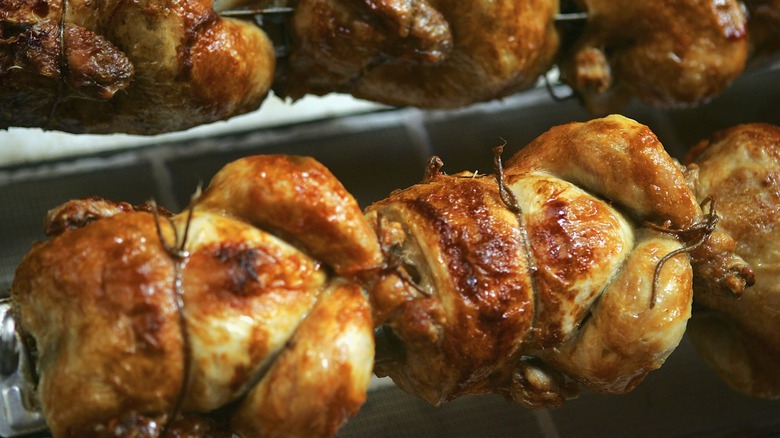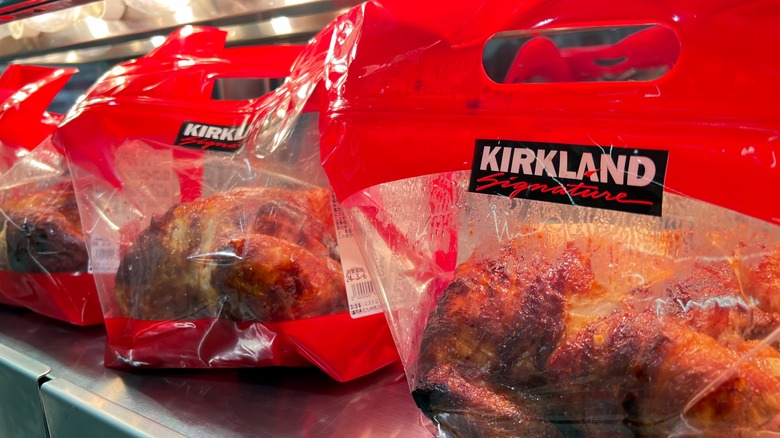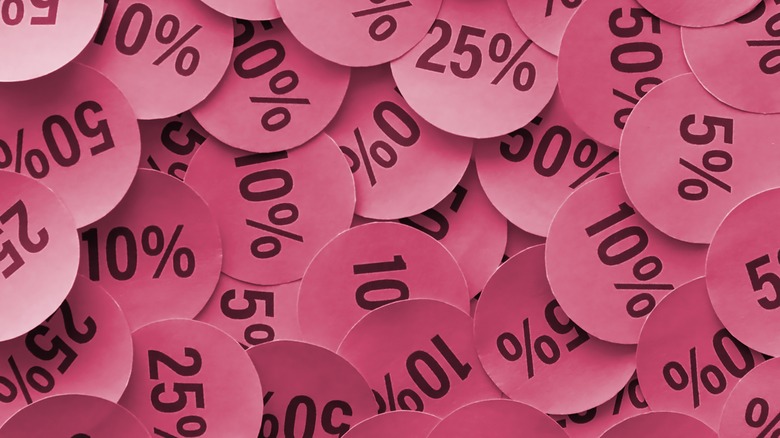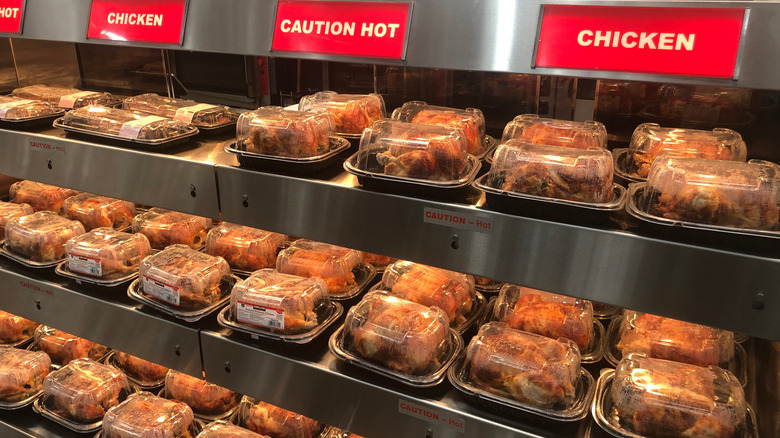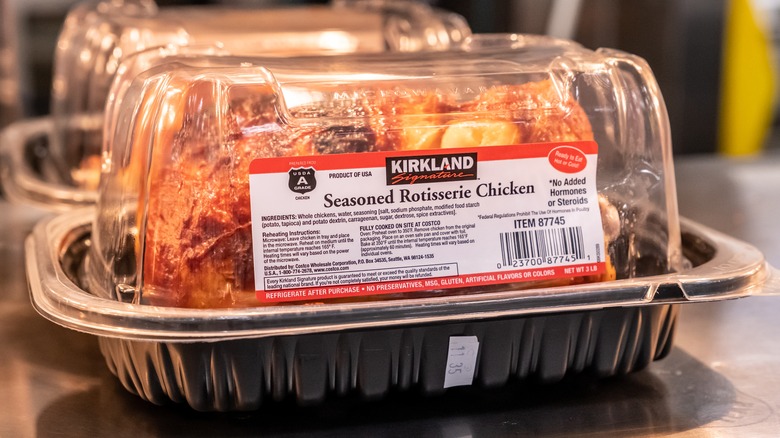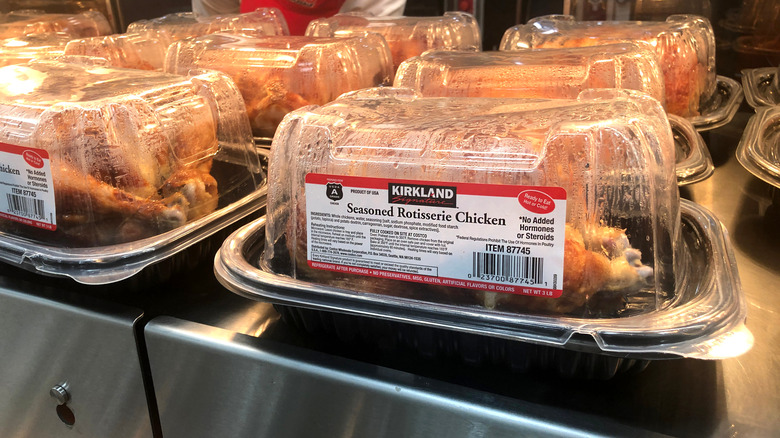5 Signs Rotisserie Chicken Has Been Sitting Out At A Store For Too Long
Grocery store rotisserie chickens can be a gift for the busy person, offering a multitude of rotisserie chicken recipes that are perfect for easy weeknight meals, work lunches, and more. However, while it's an enticing prospect to use up rotisserie chicken leftovers throughout the week, you should choose your bird carefully. While each chicken may appear to be no different to its neighbor, some will have been left out for longer than others.
There are plenty of ways to tell if chicken has gone bad, from a funky smell to a grayish tint which can appear on the inside or outside of the bird. However, these aren't things you can ascertain without actually purchasing the chicken. Cracking open a rotisserie chicken box to sample it is not an option unless you plan on making several enemies at the grocery store. Of course, you don't want to buy a product only to find that it's of poor quality (or inedible) once you get home. Luckily there are several ways you can examine a rotisserie chicken to check whether it's been left out for too long without getting banned from your local Costco.
The chicken is still out just before closing
Rotisserie chickens take a while to cook, even if you've got neat equipment to help you along the way. According to one Redditor who claimed to work in a grocery store deli, it takes around three hours to make a rotisserie chicken. Many grocery store delis don't operate on a 24-hour basis, so that leaves a fairly limited window for staff operating the deli.
This means that if you turn up to a store 30 minutes before closing and see there are still rotisserie chickens on the shelves, you may want to scrutinize these birds more carefully as they might not be fresh out of the oven. This is by no means a sure sign that the chicken is unsalvageable, as proper temperature control and regular checks can ensure it stays hot. However, the longer the chicken has been left out, the more difficult it is for it to retain its heat even in optimal circumstances and with the help of specialized equipment.
The best time to pick up a rotisserie chicken depends on how your local store times its batches. Some stores may only start cooking when the doors open, but others could start prepping earlier. In general, turning up during late morning or early afternoon gives you a pretty good chance of catching a fresh batch. Try to think in four-hour slots — one hour to prep and make other deli items, three more to cook the chicken itself.
It's sporting a reduced-price sticker
Spotting a reduced-price sticker is often a pleasant surprise, but when it comes to hot items, it can mean the item is hitting the threshold between sellable and unsellable. Employees are trained to closely monitor the temperature of hot food to comply with food safety regulations, and when an item becomes too cold, it's no longer sellable. From a business perspective, this isn't ideal — so stores may reduce a rotisserie chicken when it's clear that, by the time the next temperature check rolls around, the food will likely be too cold to sell.
On the face of it, this may not seem like a big deal. You can just reheat it when you get home, right? This thought may swirl around in your mind as you pick up that reduced-price chicken, promising a convenient bargain, but you shouldn't listen to it. Chicken is quite difficult to reheat, particularly if you're using thick cuts such as breast, thigh, or leg. If the layers aren't heated evenly, cold spots can persist — an ideal environment for salmonella. This is why chicken should never be reheated in the microwave, as microwaves can't penetrate thick layers of food effectively. If you do pick up a reduced-price chicken, make sure it's still warm and always reheat it properly in the oven or on the stove when you get home, covering with a lid to ensure an even cook.
The temperature is lukewarm or cool
Sometimes a rotisserie chicken can drop below desired temperature in spite of regular checks, and you can't always rely on an item being reduced or removed. Thankfully there are a couple of ways you can tell for yourself whether a chicken is on the cooler side or not.
The most obvious tell is appearance. Depending on your grocery store's packaging, a dropping temperature may manifest in different ways, but a freshly cooked rotisserie chicken should be giving off plenty of steam. In a plastic box or a windowed paper bag, the heat will cause the see-through parts of the packaging to steam up. However, as the bird cools, so too will the space in the packaging, meaning this steam will be unable to retain its vapor state. Therefore, if you notice heavy droplets of water on the inside of the packaging, this is a sign that the chicken has stopped producing steam, and the vapor already present has cooled to a liquid. If you can't see anything amiss with the chicken, pick up the packaging. If it feels hot or warm in your hands, all is well. If not, put it back on the shelf and try a different one.
Making sure your chicken is hot rather than lukewarm isn't just for taste. When food is left at room temperature for too long, it becomes more susceptible to foodborne illnesses, which is why it's so vital that grocery store rotisserie chickens are kept hot.
The label was printed hours ago
With all this talk of how time impacts temperature, wouldn't it be great if there was a way to tell exactly when a rotisserie chicken was made? If you look closely at the label, you may find that you're in luck. Sometimes, you'll find a sticker that shows the exact time the label was printed, allowing you to get a better idea of when the chicken was made.
The timings on these labels are not an exact science, however: Grocery store delis are typically very busy, so some employees may print the labels ahead of time so they can package and stock the chickens more quickly. Therefore, checking the time on the label should be done as a single step in a longer process.
However, if you turn up at 4:00 p.m. and the label was printed early in the morning, with enough time passing for another batch of chickens to be cooked, you can probably surmise that it's an older bird. If you have time, check each chicken and pick up the one with the most recent print time.
The packaging is soggy
The final tell can be quite difficult to detect without breaking the cardinal rule of not opening the packaging instore. Think back to earlier discussions on temperature and how, over time, steam from the chicken will turn to water droplets as the meat cools. The water will naturally pool in one place, usually at the bottom of the packaging. If your grocery store uses paper bags to store chicken, this sogginess will be pretty easy to detect. All you need to do is pick up the bag and gently touch the bottom — if it's wet, that means enough moisture has collected for it to seep through the bag.
It's harder to check plastic casings for this issue as you can't tell from touch alone, but if you gently tip the case from side to side and notice water running along the bottom of the packaging, you may have a soggy chicken. This water is different to rotisserie chicken's natural juices, which release during cooking. You shouldn't throw away the juice from a rotisserie chicken; rather, these juices should be retained for later use, such as in a salad dressing, a sauce, or as part of a gravy.
